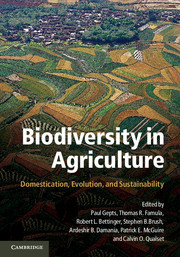Book contents
- Frontmatter
- Contents
- Tables
- Figures
- Foreword
- Contributors
- Acknowledgments
- Introduction: The Domestication of Plants and Animals: Ten Unanswered Questions
- 1 The Local Origins of Domestication
- Section I Early Steps in Agricultural Domestication
- 2 Evolution of Agroecosystems: Biodiversity, Origins, and Differential Development
- 3 From Foraging to Farming in Western and Eastern Asia
- 4 Pre-Domestic Cultivation during the Late Pleistocene and Early Holocene in the Northern Levant
- 5 New Archaeobotanical Information on Plant Domestication from Macro-Remains: Tracking the Evolution of Domestication Syndrome Traits
- 6 New Archaeobotanical Information on Early Cultivation and Plant Domestication Involving Microplant (Phytolith and Starch Grain) Remains
- 7 How and Why Did Agriculture Spread?
- 8 California Indian Proto-Agriculture: Its Characterization and Legacy
- Section II Domestication of Animals and Impacts on Humans
- Section III Issues in Plant Domestication
- Section IV Traditional Management of Biodiversity
- Section V Uses of Biodiversity and New and Future Domestications
- Index
- References
5 - New Archaeobotanical Information on Plant Domestication from Macro-Remains: Tracking the Evolution of Domestication Syndrome Traits
Published online by Cambridge University Press: 05 June 2012
- Frontmatter
- Contents
- Tables
- Figures
- Foreword
- Contributors
- Acknowledgments
- Introduction: The Domestication of Plants and Animals: Ten Unanswered Questions
- 1 The Local Origins of Domestication
- Section I Early Steps in Agricultural Domestication
- 2 Evolution of Agroecosystems: Biodiversity, Origins, and Differential Development
- 3 From Foraging to Farming in Western and Eastern Asia
- 4 Pre-Domestic Cultivation during the Late Pleistocene and Early Holocene in the Northern Levant
- 5 New Archaeobotanical Information on Plant Domestication from Macro-Remains: Tracking the Evolution of Domestication Syndrome Traits
- 6 New Archaeobotanical Information on Early Cultivation and Plant Domestication Involving Microplant (Phytolith and Starch Grain) Remains
- 7 How and Why Did Agriculture Spread?
- 8 California Indian Proto-Agriculture: Its Characterization and Legacy
- Section II Domestication of Animals and Impacts on Humans
- Section III Issues in Plant Domestication
- Section IV Traditional Management of Biodiversity
- Section V Uses of Biodiversity and New and Future Domestications
- Index
- References
Summary
The growth of archaeobotany
Archaeobotany is the specialist study at the frontier of archaeology and plant evolution. By the study of preserved plant remains from ancient human sites, archaeobotany provides evidence for use of plant resources by past cultures but also provides a record of datable ancient remains from which to document trends in the morphological evolution of crop species. As the available archaeobotanical data grow (Figure 5.1) it becomes increasingly possible to look comparatively at the trends in crop evolution, although we are still at an early stage in such research. The paper will explore some preliminary syntheses of such data, organized around a few traits of the “domestication syndrome” that are best documented in archaeobotanical macro-remains. In this exploration we focus on domestication as morphological adaptation on the part of plants, which results from the impact of human behaviors, represented by the term cultivation.
An adaptive syndrome of recurrent traits associated with cereal domestication was laid out by Jack Harlan, with his colleagues De Wet and Price, in 1973. Drawing mainly on comparative field observations of crops, their weedy races, and wild progenitors, this paper proposed both the morphological adaptations of crops and the selective pressures of human cultivators that were expected to select for them. These features were later incorporated into the taxonomically broader “domestication syndrome” of Hammer (1984). It is usually inferred that conscious intent on the part of cultivators was not necessary to explain the evolution of these traits, but rather these represented adaptation via natural selection to the anthropogenic environment of the cultivated field. As such, most domestication traits have been assumed to evolve by unconscious selection (e.g., Heiser 1988, Zohary 2004, Purugganan and Fuller 2009). Later in this chapter, through a consideration of melon domestication, I will suggest that some cases of conscious, intentional selection may differ from typical domestication processes by being faster.
- Type
- Chapter
- Information
- Biodiversity in AgricultureDomestication, Evolution, and Sustainability, pp. 110 - 135Publisher: Cambridge University PressPrint publication year: 2012
References
- 13
- Cited by



